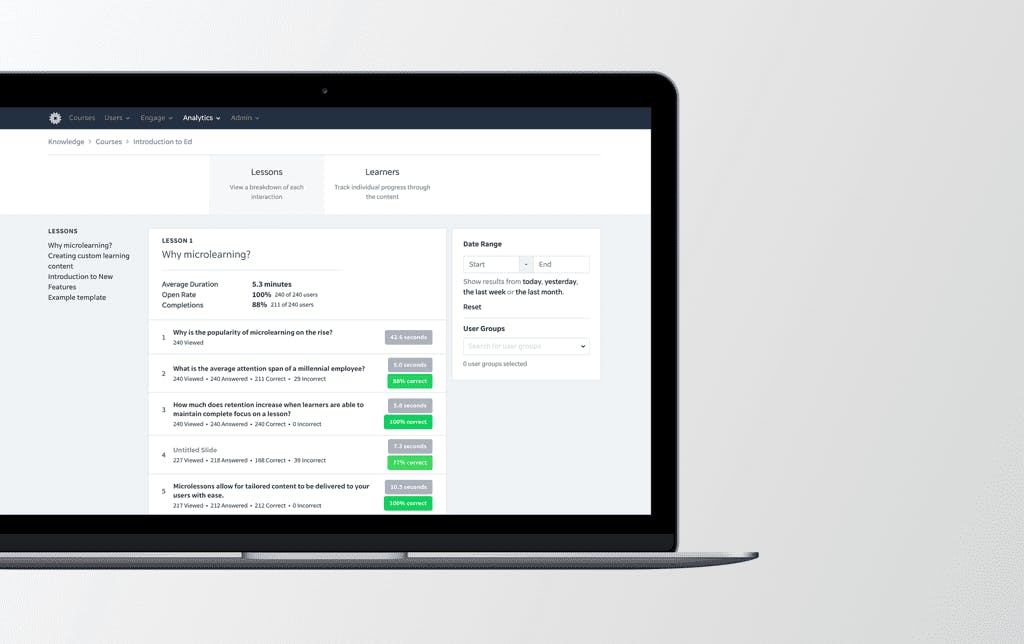Learning environment

If you have any set ideas or definitions about the term “learning environment”, feel free to erase them now. Technological advances, specifically the internet and mobile-first learning, have turned the digital learning and development world upside down.
Nevertheless, there are 5 principles which can help organize things, so let’s begin.
Working definition: learning environment
Simply put, a learning environment is any place in which people learn. At first glance, this may seem obvious, but a closer look will reveal an important realization: keeping in mind our tech companions (the internet + the smart mobile phone), we understand that wherever there is connectivity, there can be learning opportunities.
This now becomes a powerful concept. While there is still a place for classrooms, the majority of today’s professional learning is occurring outside of “school” via eLearning and blended learning in virtual learning environments. Unlikely places such as the bus or train to work, the park fountain rim on which you sit to eat your lunch, and the backyard of a home are all places that can serve as effective learning environments. This way, the online and hybrid learning process becomes a convenient experience.
Principle #1: A learning environmentlearning environmentlearning environmentlearning environment is whatever works for the teacher/trainer and the student.
Yet, are all learning environments created equal?
Tips for creating conducive learning environments
I think we can agree that although there are almost unlimited types of learning environments, some locations are better than others. Anyone who is working from home and whose young children are learning in the kitchen or living room via Zoom (or other such platforms) has learned this lesson well. Ambient noise plus frequent requests for attention make it very hard to concentrate well and do our best work.
Principle #2: Conducive learning environmentsConducive learning environmentsConducive learning environmentsConducive learning environments facilitate training by providing conditions as optimal as possible.
Here are some ideas for creating conducive environments for self-directed learning.
At one of the schools in which I taught, we had a “Quiet Room”. The room had 15 smallish desks (space for a laptop + notepad) separated by dividers. Some of the desks had computers but most did not. There was no talking allowed in this room. Whenever I had a free period, I would go there, hoping a desk was free. I was so productive in this space!
I am sure that almost every learning organization can find space for their own “Quiet Room”. It can have a combination of desks+chairs for those who want to work on a laptop or tablet and also some comfortable chairs for those who will be working solely on their phones. Since not everyone will need a desk, a smallish room will be able to accommodate quite a few trainees.
Put some attention and care into the decor of your Quiet Room. If it is inviting, your trainees will be competing to use it.
The physical space is an important part of a conducive learning environment. Equally important is the mindset of a positive learning culture. When trainees see that their organization values training, they are more likely to put better effort into completing their knowledge and skills development modules and getting higher scores while doing so.
Principle #3: Organizations set the learning culture mindset through deeds, not words. Establishing one or more Quiet Rooms is a good example. Considering that a learner who is in a Quiet Room is just as much at work as when they are at their workstation is another. In other words, managers should not open the door of the Quiet Room and say things like: “Joe, when are you planning to get back to work?”

Another area is rewards. Yes, yes: “Training should be its own reward since it is for the good of the company and your career!” (And I agree.) That’s why leaderboards are such a good idea to increase employee engagement. Via healthy competition, individuals or teams get to “boast” about being top trainees of the week.
And yet, people still like to win prizes. That’s why those “impossible to succeed at” fair games are so popular, and people spend lots of time and money to win giant teddy bears that don’t even fit into the back seat of a family car. (I know because there was hardly any space for me and my two grandkids after their dad won one for the family.)
I am not suggesting such unnecessary prizes. Yet, consider a voucher for a hot drink at a local cafe or a coupon for a fresh-baked snack from the corner bakery. You can also offer a variety of small gifts for trainees to buy with the points they win through eLearning gamification options: artisan soaps, small potted plants, storybooks or craft kits for the kids, small tech gadgets, etc.
Teaching and learning take time. Many organizations expect that trainees will spend some of their after-work-time training. I am going to suggest that this idea does not contribute to your pedagogy and a positive learning environment.
What an organization truly values it makes time for. As a result, Principle #4: Most of the training should be done as part of the workday. So, if a team is working on a project AND doing training for the future, the project timeframe (deadlines, due dates) is going to have to reflect this in a real way.
Expecting your workers to train during non-work hours makes it difficult for them to create a beneficial work-life balance. While you may get some initial training hours out of this, quite quickly, your employees are going to develop stress-related health issues. The resulting sick time/downtime/lost production is going to cost you much more than the expenses of more generous timeframes for projects and workflows.
This article has more tips on how to create positive and conducive learning environments.

Is there an ideal learning environment?
For sure! The question is: “What does it look like exactly?”
Unfortunately, there are as many answers as people. Each of us has our own idea of how and where we would prefer to learn. Mine would definitely include fuzzy blankets and vegan ice cream.
But seriously, the point is that it is unlikely that your organization is going to be able to offer the ideal learning environment for each of your trainees. What you can do, however, is get feedback from them about elements that they feel are important for their differentiated, student-centered learning programs.
Principle #5: Ask your trainees about the learning environment they would prefer.
Set up a no-name feedback method of your choice. Invite past, current, and future trainees to answer carefully curated questions about elements of their ideal learning environment. Try to get as many of your employees to answer, so the main trends will show up and be relevant for the majority of your trainees.
Once you have the data, consider the implementation. If points conflict, think about creating several learning environment options with learning models and elements that work well together.
Try EdApp for an eLearning platform that is designed to help you create other best learning experiences in any learning environment. It provides features for all your learning objectives and your workers’ learning needs, whether that be active learning. collaborative learning. self-paced learning, and so on. Your learners can collaborate through discussions and reinforce learning through assignments.
Author
